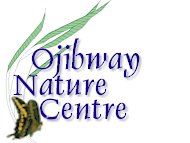

LINKS
Main Menu
Insects
Grasshoppers and Crickets
Windsor Butterfly Count
Underwing Moths
Dragonflies of Ojibway
Odonata of Essex County
Mayflies
Chiggers & Mosquitoes
STUDY TIP
Place some corn starch
in an old sock and tie
off the top. Shake the
sock over bushes or out
in an old field. The
white dust will reveal
many hidden webs!
Principal ground spiders of the Ojibway prairie include:
LYCOSIDAE
Trochosa terricola
Trochosa avara
Pardosa moesta
Schizocosa saltatrix
Schizocosa ocreata
Schizocosa avida
Pirata minutus
GNAPHOSIDAE
Gnaphosa parvula
Haplodrassus hiemalis
Zelotes subterraneus
CLUBIONIDAE
Scotinella madisonia
Phrurotimpus borealis
Castianeira gertschi
Castianeira trilineata
LINYPHIIDAE
Bathyphantes concolor
Bathyphantes pallidus
About 1,400 species of spiders are known from Canada. The sheetweb weavers (Linyphiidae) compose the largest single family with 500 species. Their dew covered webs often carpet meadows and fields at dawn.
EXTERNAL SITES
Jumping Spiders of N.Am.
International Society of Arachnology
|
Spiders at Ojibway
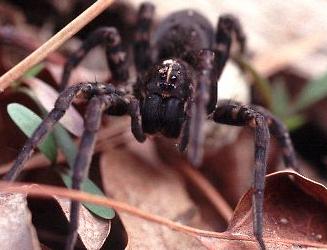
An incredible variety of these fascinating arthropods inhabit every habitat at Ojibway. By late summer spider numbers can grow to 100,000 per hectare, supported by the immense insect population at that time of year.
Prairie areas at Ojibway support large numbers of wolf spiders (Lycosidae), sac spiders (Clubionidae) and sheetweb spiders (Linyphiidae). The webs of sheetweb spiders (Linyphiidae) and orbweavers (Araneidae) are best seen on early mornings after a heavy dew. Crab spiders (Thomisidae), Lynx Spiders (Oxyopidae) and jumping spiders (Salticidae) do not spin webs but can be found on flowers and foliage.
Even your home is habitat for spiders. The two most common household spiders in Ontario are the Black-footed Spider, Cheiracanthium mildei, a species introduced from southern Europe and the House Spider, Achaearanea tepidariorum, which is responsible for most cobwebs found in buildings. The Zebra Spider, Salticus scenicus, is a small jumping spider often seen on vertical surfaces such as walls and doorways. The Funnel-web Spider, Tegenaria domestica, is a large harmless spider best known for its distinctive flat web of silk which leads back into a short tunnel where the spider rests.
The pocket sized Golden Guide to Spiders and their kin by Herbert Levi et.al. (ISBN 0307240215) provides an excellent introduction to spiders, illustrates hundreds of species and is highly recommended.
 Click here for a Checklist of the Spiders of Ojibway provided by Gergin Blagoev. Click here for a Checklist of the Spiders of Ojibway provided by Gergin Blagoev.
PHOTO GALLERY
click on image to enlarge
|
|
DYSDERIDAE
|
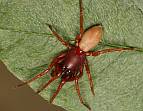
|
Woodlouse Hunter, Dysdera crocata, Aug 2007, Ojibway Nature Centre. This cosmopolitan species is the most common spider that people bring to the nature centre for identification. They are often found in in damp dark spots in and around homes. The very large chelicerae are used to pierce sow bugs (woodlice) and beetles. Photo by Tom Preney.
|
|
|
PHOLCIDAE, daddy-longleg spiders
|
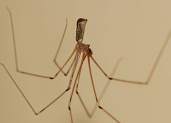
|
Long-bodied Cellar Spider, Pholcus manueli, June 2007, Ojibway Nature Centre. These common spiders build loose webs in the corners of the ceiling or other quiet corners at the nature centre. These are also called vibrating spiders. When disturbed they violently spin in a fast circular motion. Photo by Tom Preney.
|
|
|
THERIDIIDAE, cobweb weavers
|

|
female Black Widow, Latroectus sp., Oct/95, Windsor. This is one of the few spiders with a bite dangerous to humans. It is not common in the local area.
|
|
|
LINYPHIIDAE, Sheetweb and Dwarf Spiders
|
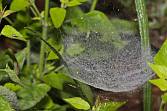
|
web of Bowl-and-Doily Spider, Frontinella pyramitela, Aug/07, Ojibway. The elaborate web consists of a small bowl, about 20cm in diameter, with a flat "doily" web below. In this early morning photo the bowl is covered in dew.
|

|
Bowl and Doily Spider, Frontinella pyramitela. This small spider is common in prairie, meadow and old field habitats.
|
|
|
ARANEIDAE, orbweavers
|

|
Female Black & Yellow Garden Spider, Argiope aurantia, Aug 24/95, Spring Garden Prairie. This is a common late summer orbweaver of prairies and goldenrod meadows.
|

|
Female Banded Garden Spider, Argiope trifasciata, Oct/99, Ojibway. This orbweaver is less common than the former species.
|

|
Dorsal view of an orbweaver, Araneus sp., Oct/96, Ojibway. This is the largest genus of spiders with over 1,500 species worldwide. Several species are found in southern Ontario.
|
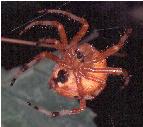
|
Ventral view of an orbweaver spider, Araneus cf. marmoreus, Sept 28/96 Backus Woods. showing prominant jaws (chelicerae) and spinerets.
|

|
A brightly coloured Marbled Orb-Weaver, Araneus marmoreus. These spiders typically hide during the daylight hours. Photo by K. Cedar
|
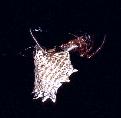
|
female Spined Micrathena, Micrathena gracilis, Sept/96, Ojibway. A common woodland orbweaver with a distinctive body shape. The large web often stretches across footpaths.
|
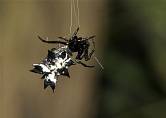
|
female Spined Micrathena, Micrathena gracilis, Aug/06, Rondeau Provincial Park
|
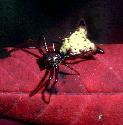
|
female Arrow-shaped Micrathena, Micrathena sagittata, Sept 15/91, LaSalle Woodlot.
|
|
|
TETRAGNATHIDAE, tetragnathid spiders
|
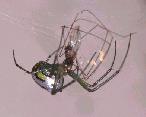
|
female orchard spider, Leucauge sp. Sept/94, LaSalle. Spiders are often attracted to the abundant prey at porch lights.
|
|
|
MITURGIDAE (CLUBIONIDAE), sac spiders
|
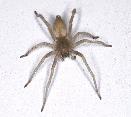
|
Black-footed Spider, Cheiracanthium mildei Sept/01, LaSalle. This small (10 mm) pale Mediterranean species is commonly found in buildings and homes.
|
|
|
PISAURIDAE, nursery web and fishing spiders
|
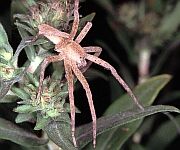
|
Nursery Web spider, Pisaurina cf. mira September 18, 2002, LaSalle. This small family of nursery web and fishing spiders (seven species in Canada) includes our largest spiders. They spin a "nursery" web when the eggs are ready to hatch.
|
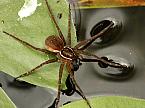
|
Six-spotted Fishing Spider, Dolomedes triton. Photographed at the pond in Ojibway Park, July 2010.
© Laurene Maycock.
|
|
|
OXYOPIDAE, lynx spiders
|
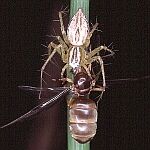
|
Lynx spider, Oxyopes scalarius August 19, 2002, LaSalle. Only two species of lynx spider are found in Canada. These small spiders can easily be identified by their prominent leg spines and tapering abdomen. They lack the "headlight" eyes of jumping spiders. This individual was in a prairie meadow where it captured a winged ant.
|
|
|
SALTICIDAE, jumping spiders
|

|
female zebra spider, Salticus scenicus, June/00 LaSalle. Jumping spiders have the best eyesight of all spiders and can be identified by the pair of prominent "headlight" eyes
|
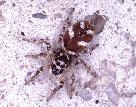
|
female zebra spider, Salticus scenicus, June/00 on concrete wall in LaSalle.
|
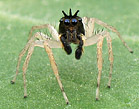
|
male Dimorphic Jumping Spider, Maevia inclemens, at Ojibway Park
© Brad Hamel.
|
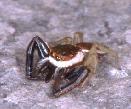
|
male jumping spider, Hentzia palmarum, Sept/98 at Ojibway Park.
|

|
male jumping spider, Phidippus clarus, June/84 at Ojibway Park. This common jumping spider is often found in plant foliage and flowers.
|

|
female Three-spotted Jumping Spider, Phidippus audax, with earwig. July 16/00. This is the most common large (15 mm) jumping spider at Ojibway. Note the bright metallic green chelicerae.
|
|
|
PHILODROMIDAE, running crab spiders
|

|
running crab spider, Tibellus sp.July/06, Ojibway Prairie. Rather than wait at a web these common spiders search for prey in grassy areas. When frightened they stretch themselves along the underside of a blade of grass and remain motionless.
|
|
THOMISIDAE, crab spiders
|
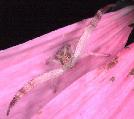
|
a flower spider, Sept/98, LaSalle. Crab spiders wait motionless in flowers to ambush insects attracted to the blooms. These spiders even attack wasps and bees much larger than themselves.
|

|
female flower spider, Misumenoides formosipes, July/00, LaSalle. Some types of crab spiders can change colour to match their surroundings. They do not catch prey in webs.
|
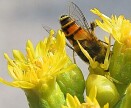
|
female flower spider in Rigid Goldenrod, August 2004 at Ojibway Park. This well camouflaged spider has captured a large hover fly.
|
|
|
Photographs © P.D. Pratt
|
Back to the top!

|


![]() Click here for a Checklist of the Spiders of Ojibway provided by Gergin Blagoev.
Click here for a Checklist of the Spiders of Ojibway provided by Gergin Blagoev.




























